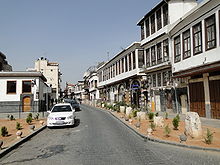- Damascus Straight Street
-
The Damascus Straight Street (Latin: Via Recta, Arabic: الشارع المستقيم Al-Shāri` al-Mustaqīm) is the Roman street (Decumanus Maximus) that runs from east to west in the old city of Damascus, Syria. It was visited by St. Paul as recorded in the book of Acts and contains several interesting sights from the Roman, Christian and Islamic periods.
Under the Greeks, the old city of Damascus was laid out after the grid pattern designed by Hippodamus. The Roman street, extending 1500 meters, used to be lined with columns and had gates on both ends, houses and shops on both sides. These columns can still be seen today. Today it consists of two main streets in old Damascus; the Avenue of Bab Sharqi and Medhat Pasha Souq, a major Damascus market, named after Midhat Pasha, the Ottoman governor of Damascus who renovated it and ordered its coverage with a lead-shade.This street, when drawn with a straight line is connected straight to the main doors of the catholic capital, The Vatican City.
In the Bible
Straight Street is mentioned in the story of Paul's conversion to Christianity in Acts 9. God speaks to Ananias in a vision, and tells him to go to the Damascus Straight Street. [1]At the house of Judas, he was to look for a man of Tarsus named Saul, as Paul was then known. Ananias is hesitant but goes anyway. After Ananias lays hands on Saul, his eyesight is restored and he is baptized.
Description
The east end of Straight Street is at Bab Sharqi, the Roman gate of the Sun. Like other monumental gates, it has a large central arch for horse-drawn vehicles and two smaller arches on either side for pedestrians. There is a minaret above the northern arch, which was built at the time of Nur ad-Din Zangi, in the 13th century.
Entering the city from the east through the Bab Sharqi, one can still see the remains of a double colonnade that used to line the entire length of the street. In Roman times, Straight Street was 26 meters wide and 1,570 meters long, lined on both sides with covered porticos containing shops. The present road follows the same line, starting at Bab Sharqi in the East, crossing the whole width of the ancient city of Damascus, and coming out at the end of Suq Madhat Pasha, 20 meters to the North of Bab al-Jabiya on the western side. The present road is narrower than the ancient one, and about 4 meters above its original level.
Almost 700 meters to the west of Bab Sharqi is a Roman monumental arch that was excavated and rebuilt in 1947 by the Syrian Department of Antiquities. It is here that the intersection of Straight Street and the north-south cardo maximus has been located. On the right-hand side in ancient times stood a Byzantine church dedicated to the Virgin Mary and called Mariamyeh. Today, on the same site, stands a church which serves as the Seat of the Greek-Orthodox Patriarchate.
The eastern section of the street from the Bab Sharqi gate to the monumental arch is called Sharee al Mustaqueem, which is the Arabic word for 'straight', but it is also known as the Suq et-Tawil, which means 'the long market'. After the arch and all the way to the western end, the street is called Suq Madhat Pasha, and is lined with shops selling textiles, cotton, domestic articles, spices, imported objects and other interesting items. It forms a part of the large commercial complex of Al-Hamidiyah Souk.
About 450 metres from the western entrance of Madhat Pasha Street, in a stretch covered with a large metal dome, is a small mosque with a balcony in the form of a pulpit that serves as a minaret, called Jakmak or Sheikh Nabhan Mosque. It is here that the Christian tradition locates the house of Judas, the place where Saul remained for three days without eating or drinking and was baptized at the hands of Ananias (Acts 9:9). The Christians of Damascus say the mosque was built over the ruins of an ancient church that commemorated the episode narrated in the Acts of Apostles. Today, the nearby House of Saint Ananias commemorates the event.
At the west end of Straight Street is the Arab Gate of the Water Trough, Bab al-Jabiya. This is where the Roman Temple of Jupiter once stood. The Mosque of Hisham (built in 1427), with fine stalactite design, is a bit further on. It is believed that the theater built by Herod the Great in the 1st century BC was in this area.
Also nearby is Chapel of St. Paul, said to be where St. Paul fled by being dropped in a basket through a window in the wall.
References
- ^ bible online Retrieved November 2011
Coordinates: 33°30′33″N 36°18′41″E / 33.50917°N 36.31139°E
Categories:- Ancient Damascus
- Streets in Damascus
Wikimedia Foundation. 2010.



